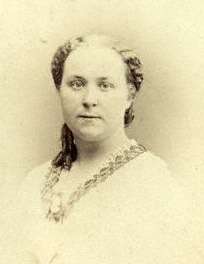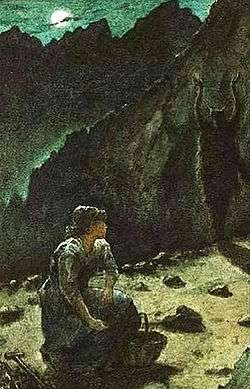The Amber Witch (opera)
| The Amber Witch | |
|---|---|
| Opera by William Vincent Wallace | |
.jpg) The composer between 1855 and 1865 | |
| Librettist | Henry Fothergill Chorley |
| Based on |
Maria Schweidler: Die Bernsteinhexe by Johannes Wilhelm Meinhold |
| Premiere |
28 February 1861 Her Majesty's Theatre, London |
The Amber Witch is an opera four acts composed by William Vincent Wallace to an English libretto by Henry Fothergill Chorley, after Lady Duff-Gordon's translation of Meinold's Maria Schweidler: Die Bernsteinhexe.
It premiered at Her Majesty's Theatre, London on 28 February 1861 conducted by Charles Hallé with Helen Lemmens-Sherrington in the title role.[1][2]
Background and performance history
The libretto was based on a Gothic novel by Johann Wilhelm Meinhold, Maria Schweidler die Bernsteinhexe, which had been translated into English by Lady Duff-Gordon and published in 1844 as The Amber Witch. The work was very popular in Victorian England and had gone through several editions by the time Wallace chose it as the subject for his fourth and most ambitious opera.[3] The novel, unlike the opera is on which it was based, retained its popularity and continued to be published both on its own and in anthologies into the 21st century. It was a favourite of Oscar Wilde's when he was a boy,[4] and in 1895 it was published in a luxury edition illustrated by Philip Burne-Jones.[5]

Wallace had sketched out most of the opera in 1860, and it premiered at Her Majesty's Theatre on 28 February 1861 with Charles Hallé conducting.[1] The Times reported that the first night's performance was a success and that "the music is almost as complicated as it is beautiful".[6] Wallace considered it his best opera,[7] and Queen Victoria attended one of the early performances, but it met with only mixed success with audiences. After its run at Her Majesty's Theatre, it transferred to the Theatre Royal Drury Lane with most of the original cast, including Charles Santley. (Euphrosyne Parepa-Rosa replaced Helen Lemmens-Sherrington in the title role.)[8] Santley recalled in his memoirs that although The Amber Witch contained some fine music, it played to nearly empty houses at Drury Lane.[9]
In 1866 at a concert to raise funds for Wallace's widow and children, two members of the original cast, Helen Lemmens-Sherrington and John Patey, sang three pieces from the Amber Witch – "Hark! How the chimes", "When the elves at dawn do pass" and "My Long Hair Is Braided".[10] The opera was revived in London in the 1880s and again in 1899 by the Moody-Manners touring company.[11] Like most of Wallace's operas, it then sank into obscurity, although Mary's aria was a popular concert piece for a time and selections from the opera (arranged for organ) were played at New York's Chickering Hall in December 1886.[12]
Roles
| Role | Voice type | Premiere Cast, 28 February 1861 (Conductor: Charles Hallé) |
|---|---|---|
| Mary | soprano | Helen Lemmens-Sherrington |
| Elsie | Fanny Huddart | |
| Count Rudiger of Ravenstein | tenor | Sims Reeves |
| Commandant | baritone | Charles Santley |
| Pastor | John Patey | |
| Claus | William Terrott | |
| King | Thomas Bartleman | |
Synopsis

The opera is set in 17th-century Germany during The Thirty Years War and tells the story of Mary, the "Amber Witch" of the title, and the daughter of the local pastor. She has discovered a vein of amber in the mountains outside her village. She uses it to buy food and clothes for the starving villagers, but tells no one of the source of her apparent wealth.
Count Rudiger of Ravenstein falls in love with her and woos her disguised as a peasant. However, the local Commandant is also in love with her. When Mary spurns his affections for Rudiger, he contrives with the aid of his jealous servant Elsie to have Mary accused of witchcraft and imprisoned. After many vicissitudes, Count Rudiger rescues Mary as she is about to be burnt at the stake, Elsie dies after taking poison, and the Commandant is banished.
Main arias and ensembles
- 'Good eve, my gentle father' (Mary, Count Rudiger, and the pastor)[13]
- 'O never laugh, Sir Knight' (Mary)
- 'Hark! How the chimes' (Mary, Count Rudiger, and the pastor)
- 'Do you want a letter?' – (Claus)
- 'A soldier must forever war be waging' (The commandant)
- 'Haughty maid' (The commandant)
- 'O bright is the palace dome' (Count Rudiger)
- 'Go sing how our troup was the first in war' (Count Rudiger and chorus)
- 'My long hair is braided' (Mary)
- 'O Lady Moon! on silver clouds reclining' (Mary and Count Rudiger)
- 'Love me and fear not I fail thee' (Count Rudiger)
- ' 'Til life at last be over' (Mary and Count Rudiger)
- 'The pain of Earth's most cruel wrong' (The commandant and the pastor)
- 'When the elves at dawn do pass' ((Mary)
- 'Lone, oppressed, in prison lying' (Count Rudiger)
- 'Come away, come away' (Count Rudiger and chorus)
- 'Paid, paid, too long delay'd?' (Elsie and the commandant)
- 'Flos perpetuus rosarum' (Latin hymn) (Mary)
- 'I Stand Beside My Grave (Mary)
- 'O am I dreaming still?' (Mary)
Recordings
There is no recording of the complete opera. Recorded excerpts include:
- the orchestral overture, on the album British Opera Overtures, performed by Victorian Opera Orchestra, Richard Bonynge (cond.), on: Somm Célèste SOMMCD 0123, CD (2013).
- the aria My Long Hair is Braided, on the album The Power of Love: British Opera Arias, performed by Deborah Riedel, Australian Opera and Ballet Orchestra, Richard Bonynge (cond.), on: Melba 301082, CD (2000).
- the arias My Long Hair is Braided and Haughty Maid, my Passion Scorning, on the album Europe Day Concert, Live from St. John's Smith Square, London 9 May 2013, performed by Dáire Halpin (soprano), Martin Piskorski (tenor), European Union Youth Orchestra, Laurent Pillot (cond.), on: Classical Recording Company CRC 2309, CD (2013).
There was also a non-commercial concert performance with piano accompaniment (10 November 2008) with the ensuing issue of a small number of CDs at the National Library of Ireland, Dublin. The title of the CD is Gems of Irish Opera vol. 1. It contains the duet O Lady Moon, performed by Aoife O'Sullivan (soprano), Dean Power (tenor), Una Hunt (piano).
References
- 1 2 Beale (2007) p. 126
- ↑ The Players (9 March 1861) p. 283
- ↑ Bleiler (1971) pp. vii-viii
- ↑ Wilde (1998) p. 3
- ↑ New York Times (17 March 1895) p. 31
- ↑ The Times, 1 March 1861, quoted in Beale (2007) p. 128
- ↑ Flood (1912) p. 28
- ↑ Mapleson (1888) pp. 28-29
- ↑ Santley (1892/2008) p. 189
- ↑ The Musical World (6 January 1866) p. 12.
- ↑ Beale (2007) p. 129
- ↑ Krehbiel (1887/2008) p. 60
- ↑ List based on the Piano/vocal score of The Amber Witch, published by Cramer, Beale & Chappell, and reproduced on Public Domain Music (pdmusic.org)
Sources
- Arundale, David, Recording Review: Power of Love: British Opera Arias, MusicWeb International, October 2002.
- Beale, Robert, Charles Hallé: a musical life, Ashgate Publishing, Ltd., 2007, p. 126. ISBN 0-7546-6137-7
- Bleiler, Everett Franklin (ed.), Five Victorian Ghost Novels, Courier Dover Publications, 1971. ISBN 0-486-22558-5
- Dwight, John Sullivan, Dwight's Journal of Music, 13 April 1861, p. 13.
- Flood, W. H. Grattan, William Vincent Wallace: A Memoir, Published at the offices of The Waterford News, 1912.
- Krehbiel, Henry Edward, Review of the New York Musical Season 1886-1887, originally published in 1887 and published in a facsimile edition by BiblioBazaar, 2008, p. 60. ISBN 0-559-65560-6
- Mapleson, James Henry, The Mapleson Memoirs, 1848-1888, Belford, Clarke & Co., 1888
- The Musical World, "Wallace Memorial Fund", 6 January 1866, p. 12.
- New York Times, "An old and famous story", 17 March 1895, p. 31.
- The Players, A Dramatic, Musical and Literary Journal, 9 March 1861, p. 283.
- Santley, Charles, Student and Singer: The Reminiscences of Charles Santley, originally published in 1892 and published in a facsimile edition by BiblioBazaar, 2008, p. 189. ISBN 0-559-00856-2
- Wilde, Oscar Complete shorter fiction with notes and introduction by Isobel Murray, Oxford University Press, 1998. ISBN 0-19-283376-6
External links
- Detailed plot description of The Amber Witch from Gladys Davidson, Two Hundred Opera Plots, ISBN 0-554-53255-7